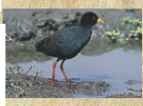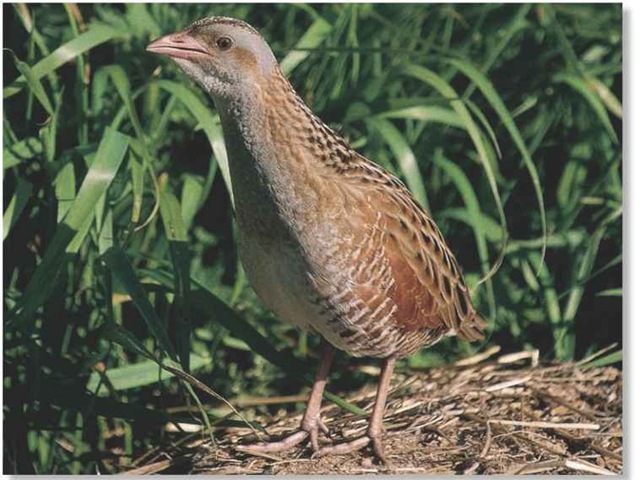ORDER
Gruiformes
FAMILY
Rallidae
GENUS & SPECIES
KEY FEATURES
Shy, skulking ground bird of rough grassland with a characteristic rasping, two-syllable call
Undertakes long, twice-yearly migrations
Threatened by loss of habitat and changing agricultural methods and classified as rare by the IUCN (World Conservation Union)
WHERE IN THE WORLD !
Breeding range stretches from western Europe east through central Asia to central Siberia; main winter range is in eastern and southern Africa
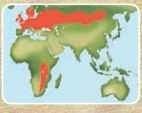
Lifecycle —
A rare, reclusive bird active at dawn and dusk,-the corncrake might go unnoticed in the-countryside if it were not for the male’s quirky but penetrating call.
HABITAT
The corncrake inhabits open, grassy regions. Its breeding haunts are the treeless steppes of eastern Europe and Asia, alpine meadows and grassy bogs in mountains, and the drier parts of marshes and fens in western Europe. It shuns forests and thickets, rocky or sandy terrain and boggy reedbeds or swamps. In early autumn, it migrates to Africa to spend the winter on grassy savannahs and plains.
Expanding human settlement across the corncrake’s range has brought change; in some cases, the replacement of forests with cereal, clover and fodder plants has expanded its habitat.
Nevertheless, its strongholds are largely confined to southern Ireland and a few islands off Scotland’s west coast.
Landslide
Natural habitat in Britain is increasingly rare.

CONSERVATION
The corncrake is widely distributed, but Eurasian populations are fragmented and in serious decline.With intact natural habitats now rare, changes in agricultural practices represent the biggest threat.They include mechanized harvesting, which kills many adults and chicks and destroys nests.
BEHAVIOR
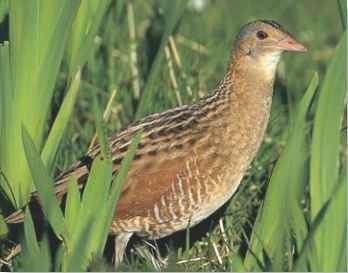
Grass roots
More often heard than seen, the corncrake spends most of the day hiding motionless in thick ground vegetation.
FOOD & FEEDING
The corncrake uses its feet to scratch at the soil to reveal food, and gathers items from the ground or from vegetation with its sharp-tipped bill. Though vegetation such as green shoots, seeds and cereal grains is part of its diet, the bulk of the bird’s intake is animal-based.
Insect prey that has been recorded include beetles, ants, earwigs, flies, crickets, grasshoppers and butterflies. Other invertebrate victims include spiders, harvestmen, earthworms, slugs, centipedes, millipedes and snails.
While most food is taken directly from the ground, the corncrake sometimes runs after active prey, such as dragonflies. Occasionally, it even takes small birds or mammals, and it is known to eat young frogs and birds’ eggs.
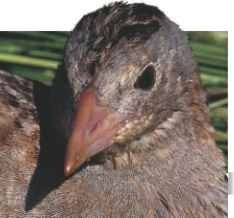
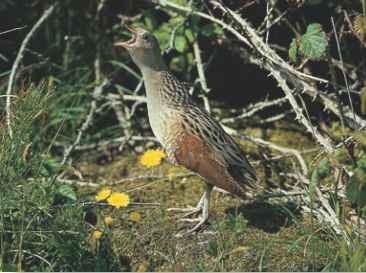
A Spring role
In April, the male begins to advertise his territory.
For most of the year, the corncrake prefers to forage in the subdued light of dusk and dawn. When active, it skulks about in grassy vegetation, holding its body low and horizontal as it weaves between the crowded stems. At the first sign of disturbance, it runs off through the cover or crouches in hiding. A sudden shock will make it take flight, where it covers the minimum distance for safety before dropping back into the grass.
At the breeding grounds, males establish territories where they try to exclude other males but attract females. Encounters between rivals and potential mates result in a similar display: the male holds his head low while spreading his wings.
Earth crake The bird pecks food from the soil with its bill.
# Corncrakes blown off course during migration have turned up in Greenland, Newfoundland, Bermuda, Australia and the United States.
The corncrake derives its name from its monotonous call, which is like a raspy crake, crake.
# The corncrake’s nesting chances are improved if meadows are not cut until midsummer. But devices that frighten them out of harm’s way can be added to harvesting machinery.
BREEDING
Following a brief courtship and mating at the breeding grounds, the female corncrake builds a bowl-shaped nest of grass and herb stems on the ground amid dense cover She lays 8-12 spotted eggs in the nest, producing the clutch over a period of a few days. Incubation begins once the last egg is laid, ensuring that all the young hatch out at roughly the same time—usually about two-and-a-half weeks later
The chicks are well developed upon hatching, with dark brown plumage. They quickly gather enough leg strength to leave the nest. Although the male plays no part in incubation, he sometimes helps feed the young as they follow the parents around for the first three or four days. Within a week, the chicks feed independently, but they stay close by the adults until molting into their flight feathers at about 5 weeks old.
NEW TO THE FIELD
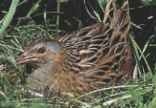
A Single sitting The female incubates the eggs on her own.
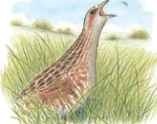
1 Dual-purpose call…
A male corncrake calls from his territory to warn other males and appeal to potential mates.
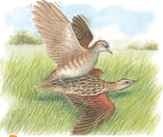
2 Grass court…
A nearby female responds to his cry, and the two birds display for a while before they finally mate.
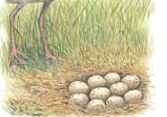
3 Clutch control…
The female lays her eggs in a nest hidden by surrounding stems; she rarely strays far from them.
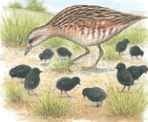
4 Parental guidance
Once hatched, the chicks follow their parents around and learn to forage for themselves.
Profile
Corncrake
Bedecked in cryptic camouflage, the corncrake only forsakes ground cover if a close encounter with a predator forces it into flight.
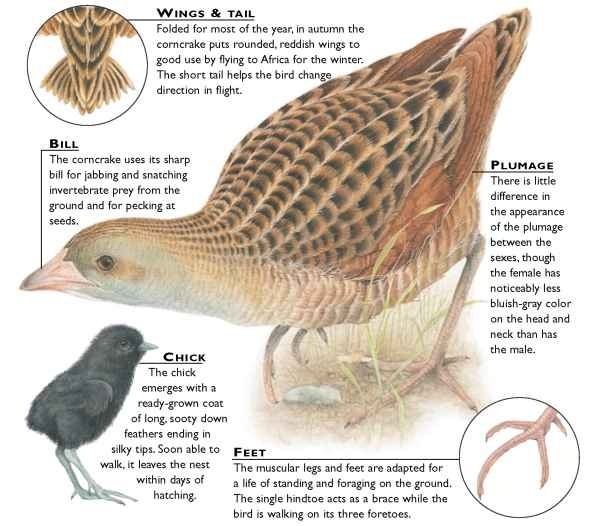
CREATURE COMPARISONS
The corncrake shares much of its breeding range with the water rail (Rallus aquaticus), though the two species select different living quarters. As its name suggests,the water rail is closely associated with marshes, swamps and ponds surrounded by emergent vegetation.Though slightly smaller in build than the corncrake, it has a much longer bill designed for probing in water and soft mud. Many of its populations are migratory but, unlike those of the corncrake, they limit their travels to the Mediterranean region and southern Asia.
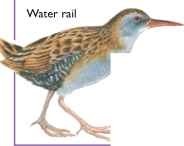
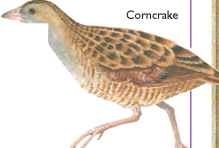
| VITAL Weight |
STATISTICS Male 4.5-7.5 oz.; female 5-5.5 oz. |
| Length | 11-12″ |
| Wingspan | 18.5-21″ |
| Sexual Maturity | 1 year |
| Breeding Season | April-August |
| Number of Eggs | 8-12 |
| Incubation 1 Period | 16-19 days |
| Fledging Period | 34-38 days |
| ^Breeding Interval | 1 or 2 broods a-year |
| Typical ; Diet | Insects, other invertebrates; green shoots, seeds |
| : Lifespan | Not known |
RELATED SPECIES
• The sole member of its genus, the corncrake is 1-of 124 species in 41 genera in family Rallidae; it includes rails, coots, gallinules and crakes, such as the black crake, Amaurornis flavirostris (below). The closest U.S. relative is the black rail.
